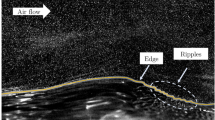Abstract
An analysis of velocity statistics and spectra measured above a wind-tunnel forest model is reported. Several measurement stations downstream of the forest edge have been investigated and it is observed that, while the mean velocity profile adjusts quickly to the new canopy boundary condition, the turbulence lags behind and shows a continuous penetration towards the free stream along the canopy model. The statistical profiles illustrate this growth and do not collapse when plotted as a function of the vertical coordinate. However, when the statistics are plotted as function of the local mean velocity (normalized with a characteristic velocity scale), they do collapse, independently of the streamwise position and freestream velocity. A new scaling for the spectra of all three velocity components is proposed based on the velocity variance and integral time scale. This normalization improves the collapse of the spectra compared to existing scalings adopted in atmospheric measurements, and allows the determination of a universal function that provides the velocity spectrum. Furthermore, a comparison of the proposed scaling laws for two different canopy densities is shown, demonstrating that the vertical velocity variance is the most sensible statistical quantity to the characteristics of the canopy roughness.









Similar content being viewed by others
Notes
The void fraction is here defined as the ratio between the canopy volume occupied by the fluid and the total canopy volume.
References
Alfredsson PH, Örlü R (2010) The diagnostic plot—a litmus test for wall-bounded turbulence data. Eur J Mech B 29:403–406
Belcher SE, Jerram N, Hunt JCR (2003) Adjustment of a turbulent boundary layer to a canopy of roughness elements. J Fluid Mech 488:369–398
Dupont S, Brunet Y (2009) Coherent structures in canopy edge flow: a large-eddy simulation study. J Fluid Mech 630:93–128
Harman IN, Finnigan JJ (2007) A simple unified theory for flow in the canopy and roughness sublayer. Boundary-Layer Meteorol 123:339–363
Irwin HPAH (1981) The design of spires for wind simulation. J Wind Eng Ind Aerodyn 7:361–366
Jackson PS (1981) On the displacement height in the logarithmic velocity profile. J Fluid Mech 111:15–25
Johansson AV (1992) A low speed wind-tunnel with extreme flow quality—design and tests. Technical Report, ICAS-92-3.8.1
Kaimal JC, Finnigan JJ (1994) Atmospheric boundary layer flows. Their structure and measurement. Oxford University Press, Oxford, 289 pp
Lindgren B (2002) Flow facility design and experimental studies of wall-bounded turbulent shear-flows. PhD Thesis, KTH, Stockholm
Meroney RN (1968) Characteristics of wind and turbulence in and above model forests. J Appl Meteorol 7:780–788
Mölder M, Grelle A, Lindroth A, Halldin S (1999) Flux-profile relationships over a boreal forest roughness sublayer corrections. Agric For Meteorol 98:645–658
Novak MD, Warland JS, Orchansky AL, Ketler R, Green S (2000) Wind tunnel and field measurements of turbulent flow in forests. Part I: uniformly thinned stands. Boundary-Layer Meteorol 95:457–495
Panofsky HA, Dutton JA (1984) Atmospheric turbulence: models and methods for engineering applications. Wiley, New York, 418 pp
Pietri L, Petroff A, Amielh M, Anselmet F (2009) Turbulence characteristics within sparse and dense canopies. Environ Fluid Mech 9:297–320
Poggi D, Katul GG, Albertson JD (2004) A note on the contribution of dispersive fluxes to momentum transfer within canopies. Boundary-Layer Meteorol 111:615–621
Raupach MR, Shaw RH (1982) Averaging procedures for flows within vegetation canopies. Boundary-Layer Meteorol 22:79–90
Schlichting H (1968) Boundary layer theory, 7th edn. McGraw-Hill, New York, 817 pp
Segalini A, Fransson JHM, Alfredsson PH (2011) An experimental analysis of canopy flows. J Phys: Conf Ser 318:072018
Seginer I, Mulhearn PJ, Bradley EF, Finnigan JJ (1976) Turbulent flow in a model plant canopy. Boundary-Layer Meteorol 10:423–453
Shaw RH, Schumann U (1992) Large-eddy simulation of turbulent flow above and within a forest. Boundary-Layer Meteorol 61:47–64
Talamelli A, Riparbelli L, Westin KJA (2004) An active grid for the simulation of atmospheric boundary layers in a wind tunnel. Wind Struct 7:131–144
Thom AS (1971) Momentum absorption by vegetation. Q J R Meteorol Soc 97:414–428
Thomas C, Foken T (2007) Organised motion in a tall spruce canopy : temporal scales, structure spacing and terrain effects. Boundary-Layer Meteorol 122:123–147
Tutu NK, Chevray R (1975) Cross-wire anemometry in high intensity turbulence. J Fluid Mech 71:785–800
Acknowledgments
This work is part of Vindforsk III, a research program sponsored by the Swedish Energy Agency.
Author information
Authors and Affiliations
Corresponding author
Rights and permissions
About this article
Cite this article
Segalini, A., Fransson, J.H.M. & Alfredsson, P.H. Scaling Laws in Canopy Flows: A Wind-Tunnel Analysis. Boundary-Layer Meteorol 148, 269–283 (2013). https://doi.org/10.1007/s10546-013-9813-2
Received:
Accepted:
Published:
Issue Date:
DOI: https://doi.org/10.1007/s10546-013-9813-2




